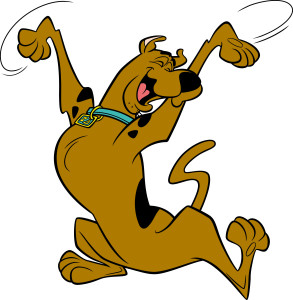True story: some college students were touring a county coroner’s office. The tour included visit to an autopsy room, where a coroner and a diener were in the process of examining the body of a deceased unfortunate. The diener, with the students looking on, turned the corpse over and exclaimed, “Rut row!” The reason for this utterance was that the corpse had a tattoo of Scooby Doo inked into one cheek of his posterior. Gallows humor, indeed.
Scooby Doo is firmly ensconced in the American culture. The plot of each cartoon episode is very similar, with a crime occurring, Scooby and his pals investigating, and the villain of the piece being unmasked, literally, at the end. I think that I
first heard this type of climax referenced as a “Scooby Doo” ending during the second of the three climaxes to the film Bill & Ted’s Excellent Adventure. It has been a vehicle used in mystery novels long before that. There’s nothing wrong with it at all, except that 1) it sometimes doesn’t work and 2) sometimes it needs a little work. I ran across an example of the former several months ago while reading a thriller that was one of the many nephews to The Da Vinci Code wherein the protagonist’s adversary was running around killing people while wearing a tribal mask and attempting to obtain an instrument of antiquity which would permit him to destroy the universe. The protagonist got the mask off of the evildoer near the end and the book ended. “Rut row!” The book was okay, but the ending was a total disappointment.
That brings us to a book I read this week in which the author uses the Scooby Doo ending to great effect by taking the story a step or two beyond it. The author is the morbidly underappreciated Brian Freeman and the book is Season of Fear, the second and latest of the Cab Bolton novels. (Please note: it’s not quite a spoiler, but there’s a general revelation ahead. Read the book regardless). The premise is fairly straightforward. Ten years ago a Florida gubernatorial candidate was assassinated by a masked gunman, throwing the election into chaos. A suspect was identified, tried, convicted, and jailed. In the present, the candidate’s widow is running for the same seat when she receives a threatening note which purports to be from the same assassin. Indeed, he eventually turns up, and his identity is ultimately revealed in a grand unmasking. But wait. Freeman, after giving the reader enough action to fill two books and expertly presenting a complex but easy to follow plot, gives the reader more to chew on. Things don’t end with the revelation of the identity of the doer; instead, Freeman moves us a couple of more steps forward, revealing a potential unexpected mover and shaker who was a couple of steps ahead of everyone, including Bolton. This has the double-barreled effect of making the climax much more interesting and setting up a potential adversarial setting for Cab Bolton in a future novel. Nice work.
Again, Scooby Doo endings are okay. They’re fine. But if your particular novel in waiting has one, and seems to lack pizazz, don’t just take the doer’s mask off, or reveal their identity, or whatever. Take things a step further just as the curtain is going down, and reveal who is pulling the cord, and perhaps yanking the chain. It may be a character that was present throughout your book, or someone entirely new, or…well, you might even want to create a character and work your way backwards with them. But stay with the mask, and go beyond it.
So what say you? Have you read anything recently where the ending really surprised you, unmasking revelations or otherwise notwithstanding? Do you like Scooby Doo endings, in your own work or the work of others? Or can you do without them?
Oh, lest I forget… SCOOBY-DOO and all related characters and elements are trademarks of and © Hanna-Barbera. Rowwrr!
Killzoneblog.com



Excellent point. The quest is always to surprise the reader, and to deliver more than what’s expected.
So at the end, the kids all say, “The Phantom was Mr. Parker, the gardener! And he was working for Councilman Stone, who wanted to be mayor!”
Thanks, Mike. Or to put it another way, “It was Colonel Mustard in the library with a candlestick!”
…oops…wrong cultural icon…
BTW…I was sorely tempted to answer each and all of the comments today in Scooby language, but decided against it….
The other day I heard a fellow author complain about another author this way: He always has that twist at the end…and then another twist….and then a twist after THAT, and then a FINAL twist.
Thus, my question for you, Joe: Is a single Scooby better than a double? Can you have too much of a good thing?
Jim, answering only for myself, I’ll give that a definitive “usually.” Indeed, the situation which your source described can spiral out of control, creating a vortex that sucks the entire story down. I’ve seen that happen, most memorably in a much-anticipated sequel to a mega-best seller. There was a thunderous climax, and then…for what seemed like three hundred pages (but wasn’t quite that many) the protagonist and an “explainer” wandered through an exotic city as the explainer (who was grievously wounded, by the way) pulled the curtain behind the curtain back and related the reasons for all that had occurred. So…can you have too much of a good thing? In that case, and many others, certainly. Thanks for stopping by and raising the issue.
“A double Scooby with a half gainer?” Increasing the difficulty factor of course increases the core from the judges, who in this case are the readers.
My favorite part of the “Wayne’s World” Scooby ending was that they went to the trouble of setting it up right at the beginning, in the doughnut shop scene. “How are things at the old amusement park?” If you’re going to do a bit, commit to it.
John, you are right, it WAS Wayne’s World that had the Scooby ending!!! Thank you. And you bring another important point to our table, that being that you can’t just tack on an ending behind the ending, as it were. You have to go back into the meat of the story and drop a few breadcrumbs disguised as, uh, other types of droppings, the types that people will notice but walk around and then pay no further mind, so that when the ultimate ending comes, they can say, “Whoa!” or “Hmm!” as the case may be. Thanks again.
Ha! Never heard it called a Scooby Do before, but it’s perfect. Must remember this for teaching purposes! I was reading a book by a Famous Author a while back — happily finishing it up on the deck in the Michigan woods with my glass of wine — when the author pulled a triple-Scooby. I was so put-off I chucked the paperbook into the woods. It was one twist over the line, sweet Jesus. And the writer didn’t even need it because the double-Scooby was perfect.
Kris, what a visual! I see the book doing a double half-gainer into the woods, and then Scooby in the side yard, doing that running-but-going-nowhere thing with the percussion, before gaining his footing and taking off after the book and bringing it back, ripping it to shreds in the process. Rowwr! Thanks!
Joe, great post.
I, too, had never heard this type of ending called a Scooby Doo ending.
I like the multiple layers of complexity, during the middle, where one layer of evil after another is revealed, as the protagonist’s focus keeps changing. But at the ending, more than one Scooby starts to feel contrived, and takes away some of the oomph from the first Scooby. I agree that sometimes less is better.
Thanks for another great post.
Thank you as always, Steve, for stopping by, your kind words, and astute observations on this fine Saturday. Sometimes it can work more than once — Jeffery Deaver is a master of it, geez, I mean he’s maniac good with that type of thing — but for most of us, one corkscrew twist (if that, for me) is all we can manage. Thanks again and take care of yourself.
I have no profound writerly thoughts to add but Scooby is my cartoon hero so this post made my day! 😎 Just seeing his picture makes me hear the Scooby stuffed toy I have packed away somewhere–you squeeze him and he says “Oh boy! Oh boy! Scooby snacks!” 😎
BK, making peoples’ days is what we are all about here at TKZ and I’m happy that I could be a part of making yours! Thanks for letting us know.
I, too, was unfamiliar with the term, Scooby Doo ending, and I love the description (and pictures). I enjoy a twist but agree that less is more with the doubles and triples unless adroitly handled and make sense when the hints are re-examined. Thanks for expanding my awareness and my vocabulary.
Thanks for this article. I love Scooby Doo endings. But you reminded me too much of it can be annoying. The flick Predestination makes me think of a Scooby Doo ending. I saw the ending coming but it still made me overthink(?) it all. And this article helped me take a harder look at my current story. I don’t think I’ve gone overboard but it’s encouraged me to add more questions to ask my beta readers. Thanks again!
David, you’re welcome, and thanks for your kind words. Sometimes we are our own toughest critics, but it’s a great idea to run additional questions past your beta readers regarding endings. Hope it works out and we look forward to seeing your story at some point.
You’re welcome, Julie, and thank you for your observations which are spot on, imho.
I totally agree with this,and in fact I was about to mention some importance of new homes Parish FL in my comment below.
It’s certainly a fact that helps makes us work more and faster.see more
new homes Parish FL